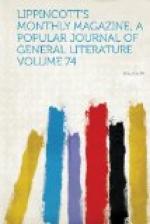[Illustration: A JAGUAR TRAP.]
After a brief siesta M. Forgues and his companion resume their journey toward Villa Rica. Under a shed on the roadside they see a dozen women, all talking at the same time, and engaged in grating manioc-roots in pails of water. The mixture thus obtained composes the dough of manioc. This dough is very white, and is made into small balls which are pressed between the hands—an operation which, when completed, constitutes the entire process of making a coarse kind of bread, not at all of delicate flavor, called galetta, which is furnished to laborers of both sexes. Under another shed a young girl with a complexion like bronze is seated before a loom weaving, with a light and elegant shuttle, a hammock out of the cotton thread of the country.
Evening is about deepening into night when M. Forgues arrives at Villa Rica. His host in the town, a prosperous shopkeeper, invites him to dinner, and at the table he meets the mistress of the house, a tall, handsome Paraguayan woman, who receives him and his fellow-traveler with polished courtesy. She belongs to the class of the posterity of the old Spanish colonists. She is dressed in a long calico dress with a white train, and with a row of small red buttons down the front. The sleeves have deep cuffs, also fastened with small buttons. A wide, turned-down collar partly covers the shoulders, and exposes to the sight the lower part of a very shapely neck. In the course of conversation this lady informs M. Forgues that the department of Villa Rica is perhaps the only part of the country which may give an idea of what Paraguay was before the war. The men, it is true, were killed off, as were the men of the other departments, but by a happy chance the women and children were spared that terrible flight to the Cordilleras whereby thousands of their sex and age perished. His hostess relates to him her experiences during that fearful period. After the occupation of Asuncion by the Brazilians, and their advance as far as Paraguari, Lopez gave the order that Villa Rica should be abandoned and that the population should follow him to the mountains. As it happened,




